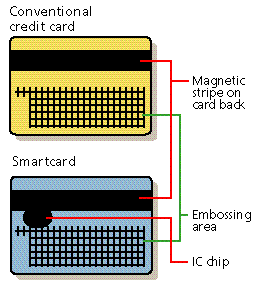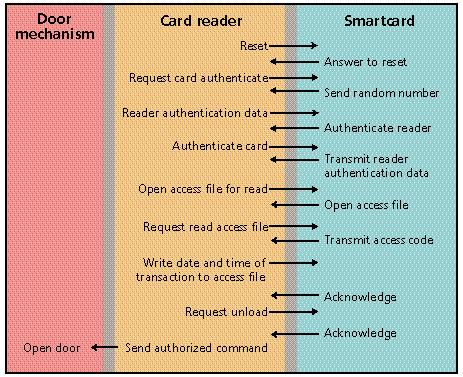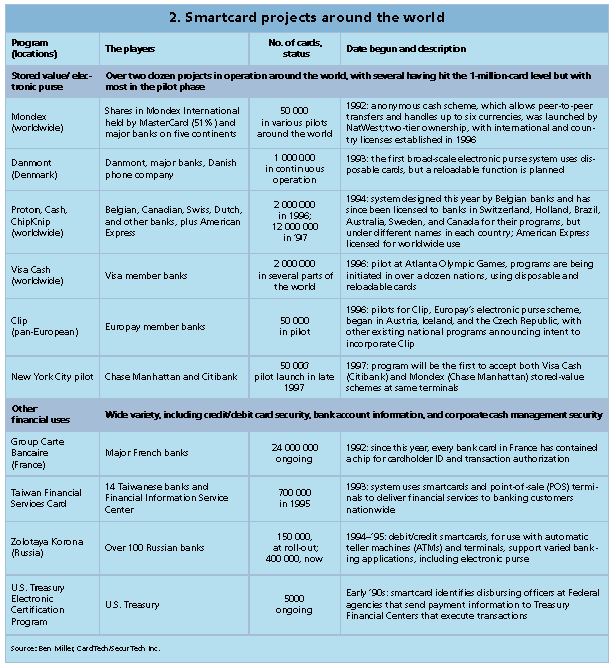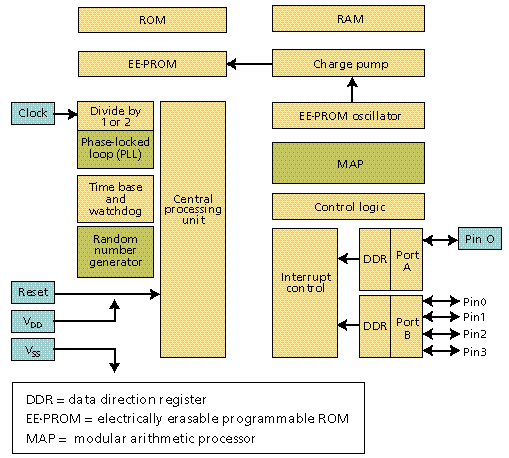In Your Pocket: Smartcards
The worldwide boom in smartcard deployment is accelerating their evolution
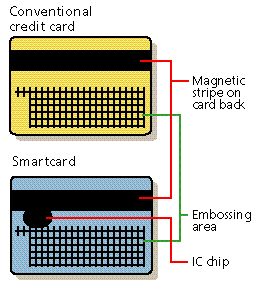
Take a look in your wallet and what do you find? In all likelihood, bills and coins. A variety of credit cards. A driver's license. A transit pass. A voter registration card. A library card. A video rental card. Insurance cards. Frequent flyer and car rental cards. A telephone charge card.
By the end of the century, all of these documents might be replaced by just two or three smartcards. Because they can store and protect relatively large amounts of data, smartcards are being used in a number of ways around the world, replacing a wallet's contents bit by bit. Stored-value cards were in place last year in Atlanta, Ga., at Olympic venues standing in for coins and bills. A health card identifying the holder's insurance provider and account number has been issued to every citizen of Germany, and plans are in place to add such medical information as the name of the holder's doctor, blood type, allergic reactions, medications, next of kin, and instructions in case of emergency. Smart social security cards in Spain interface with a kiosk system that can provide updated information on benefits and eligibility, as well as pertinent job opportunities.
Today, most smartcards handle a single application, but will realize their true value when a single card can address multiple applications. For example, a credit card could have a stored-value function for small purchases, in addition to frequent flyer and rental car information. It might work with a cellular phone to connect the user to a home banking service. One step toward this goal was last fall's announcement by VeriFone Inc., Redwood City, Calif., of a system called VeriSmart, which permits a smart phone or a PC to act as a "personal ATM" (automatic teller machine) in the home, loading cash value onto a smartcard
The smartcard will also be a tool for addressing the "customer of one": applications of special interest to the card holder will be loaded onto the card to make life easier. Eventually, people may customize generic cards themselves from a menu of applications. In a report on the smartcard industry, semiconductor industry analyst Dataquest Inc., San Jose, Calif., recently wrote, "Although some standards issues, infrastructure issues, and software issues remain to be resolved, chip cards hold the promise of being one of the world's highest-volume markets for semiconductors."
As a single card comes to hold more information and relates to more aspects of its holder's life, privacy concerns will have to be addressed. Note, however, that the information stored in a smartcard is usually already available in some format or another; the smartcard merely makes that information portable and puts it at the disposal of the card carrier.
The smartcard application that will be most popular in North America may involve a portable token--a card, a key, or some other familiar shape--for conducting transactions over the Internet, particularly for home shopping and home banking. How can such sensitive information as financial transaction data be safely communicated across a hacker's paradise like the Internet?
Advanced cryptographic functions will be required. Public key encryption (PKE) will be part of the solution in at least two ways [see "Locking the E-Safe"]. First, PKE (often a one-session key) will be used to encrypt data to be transferred with the receiver's public key. This data will be readable only by a receiver with the secret key. The second use will be for digital signatures: a piece of data encrypted by the sender's private key, proving that only the authorized sender could have sent a message or that it has not been modified. PKE capabilities using Smartcards provide for portability, cutting the tie to any specific computer, phone, or other "site."
These smartcard applications require the development of infrastructures that are global, interoperable, easy to update, and capable of supporting several applications concurrently. The Dataquest report on the smartcard market indicated that 156 million smartcard microcontroller devices would be shipped in 1996, increasing to 990 million in the year 2000. Suppliers of smartcard silicon include Motorola, SGS-Thomson, Philips, Siemens, and Hitachi.
A smartcard primer
Physically, a smartcard resembles a credit card having one or more semiconductor devices attached to a module embedded in the card's top left corner, providing contacts to the outside world [Fig. 1]. Also referred to as an integrated-circuit card, or ICC, the card can interface with a point-of-sale terminal (POS), an ATM, or a card reader integrated into a phone, a computer, a vending machine, or any other appliance.
The semiconductor device embedded in a true smartcard is a microcontroller. It is the microcontroller that makes a card smart and capable of undertaking a range of computational operations, protected storage, and decision-making. Other silicon chips, such as memory devices, can be embedded, too, but cards with these alone are called memory cards.
Smartcards have two main advantages over magnetic-stripe cards. They can carry 10100 times as much information (current smartcards provide up to 8KB, about two typed pages) and hold it more robustly and securely than do typical magnetic-stripe cards. (Anyone with larceny in mind might want to know that most magnetic-stripe cards can be read and written with equipment readily available from many hobby stores.) In conjunction with a terminal, smartcards can also execute complex decision-making tasks, including handshake routines that prove the card's validity to the terminal and the terminal's validity to the card--a form of mutual authentication that can reduce fraud and misuse [Fig. 2].
The main benefits of smartcards are increased data security, an active antifraud capability, flexibility in applications, a multipurpose capability, and off-line validation. In practice, these features are interrelated, but perhaps the most important of them is a higher level of security than such alternative technologies as magnetic-stripe cards or simple memory cards can provide. This makes smartcards viable in applications involving money, proprietary secrets, and personal data. A smartcard, for example, can be combined with biometrics--information representing fingerprints, hand geometry, and so forth--to uniquely "connect" the card holder's identity to the card.
Current standards define the mechanical, physical, electrical, and handshake interfaces between the card and the reader without restricting the silicon embedded in the card to a particular application. Because smartcards have global applications, standards are necessary to provide for future uses and for technological advances while also ensuring that the cards will be universally accepted and that tomorrow's applications can work together.
Standards dealing with digital cellular telephones, Internet access, airline ticketing and frequent flyer programs, and financial applications are being addressed globally [Table 1]. The EMV (Europay/MasterCard/Visa) standard addresses the use of smartcards in financial payment systems, defining the basic protocols for communication between cards and readers. In 1996, Microsoft Corp., Redmond, Wash., announced a joint effort in this area with Hewlett-Packard, Bull CP8, Schlumberger Electronic Transactions, and Siemens-Nixdorf Informationssysteme. Their aims: to promote the acceptance of smartcards in the PC environment, and to develop a set of open standards enabling PCs to work with such smartcard applications as network access and electronic commerce. Microsoft also announced its Internet Security Framework, which uses digital certificates--either in software on a user's PC or on a smartcard device--to secure Internet connections.
Silicon in the card
The microcontroller used in Smartcard applications [Fig. 3] contains at a minimum a central processing unit (CPU) and blocks of memory, including RAM, ROM, and nonvolatile memory--usually electronically erasable programmable ROM (EE-PROM).
The inclusion of a variety of memory types helps suit the smartcard microcontroller to a range of applications. For example, RAM serves to calculate results and stack memory, ROM to store the operating system, fixed data, standard routines, and lookup tables. The nonvolatile memory is the most versatile; EE-PROM, for instance, serves to store information that must not be lost when the card is not connected to a power source but that must also be alterable to accommodate data specific to individual cards or any changes possible over their lifetimes. This information might include a card identification number, a personal identification number (PIN), authorization levels, cash balances, and credit limits. Typical features for today's applications include an 8-bit CPU, 128780 bytes of RAM, 420Kb of ROM, and 116Kb of EE-PROM on a single die, plus, as an option, an on-chip hardware encryption module.
With security in mind
Although the smartcard microcontroller works like any microcontroller, it is fundamentally different: while maintaining instruction set compatibility, it is designed with security in mind. For example, the smartcard and nonsmartcard versions of the Motorola 68HC05 8-bit microcontroller display several clear differences,..
Probably the most obvious is the single I/O of the microcontroller in the smartcard, versus several 8-bit ports for a normal microcontroller. In fact, a smartcard device has only five standard pinouts: I/O, clock, power, ground, and reset, whereas other microcontrollers usually have at least 16 pins and sometimes more than 50.
Memory configurations are different, too: a smartcard uses only on-board memory with relatively large amounts of nonvolatile memory, usually EE-PROM. The EE-PROM is programmed by an on-chip charge pump controlled by the CPU and not accessible directly by external command. A third difference is that the device appears stripped down as compared with nonsmartcard devices, since it contains no additional peripherals such as analog-to-digital converters, pulse-width modulators, and serial or parallel interfaces.
Smartcard devices, which are very constrained by die size, use very dense memory elements. Surprisingly, this restricted die size does not automatically lead to the use of state-of-the-art fabrication geometries. First, cost is a great factor in smartcard applications, which may involve issuing tens of millions of cards. Second, large volumes also require established and extensive fabrication facilities. Third, the need for security means that a well-defined, characterized, and tried-and-true process is needed, since a new one might include some as-yet-undetected anomaly that could compromise security. For these reasons, smartcard microcontrollers tend to be fabricated in 0.71.2-µm CMOS technologies, moving to finer geometries as they become less expensive and fully characterized.
The use of smartcards in security-sensitive applications heavily influences the design and handling of the card--silicon and software alike. Microcontrollers used in smartcards are specifically designed to restrict access to stored information and to prevent the card from being used by unauthorized parties. To accomplish this, each microcontroller manufacturer includes its own set of security features, many of which are never discussed since they are useful only if potential hackers do not know that they exist.
Smartcard devices are designed to work only in well-characterized operating environments, since one attack scenario involves attempts to force cards to operate outside normal operating voltage or clock frequency ranges, in hopes of uncovering weaknesses that can be exploited. Most devices therefore detect and reset whenever they are pushed outside their normal operating ranges. A card's reactions upon sensing attempt at fraudulent access range from ignoring the access request to locking up the card from all future use. Other features provide special functionality to areas of memory or make it difficult to access portions of memory or circuitry directly. Such techniques as memory-scrambling, hidden layers, and dummy circuitry may be added to confuse hackers.
No system can be considered entirely secure; all must constantly be evaluated and improved. Given enough resources, time, ingenuity, and perhaps luck, almost any system can be broken. But we are not without recourse. Security aims to make a system more difficult to break than the effort would be worth to criminals. As a result, we see different levels of security precautions, from simple PIN numbers to full biometrics, or from simple algorithms to Data Encryption Standard (DES) or Rivest, Shamir, Adelman (RSA) encryption. For example, in financial cards, a device can use PIN numbers, or fingerprints or some other biometric, to verify users. The microcontroller's ability to perform certain algorithms enables the card to verify the reader as well as the reader to verify the card, frustrating such scenarios as occurred in a Washington, D.C., mall, where a fake ATM machine was set up to collect names plus account and PIN numbers for fraudulent use. The EE-PROM can record transaction data for later reconciliation.
But any system is only as secure as its weakest link. Security must be regarded as a system-wide undertaking, for it is pointless to double-lock the front door if the back one is wide open. Also, technology is a wonderful thing but criminals, too, can use it: as new equipment and techniques become available or less expensive, the barriers to cracking a system may weaken. Recently Bellcore announced a paper, "Cryptanalysis in the presence of hardware faults" (available at www.bellcore.com), that proposed a theoretical method for breaking an asymmetric encryption code once a computer (or a smartcard microcontroller) had been forced into faulty behavior.
The Smart Card Forum, a multi-industry membership organization headquartered in Tampa, Fla., has stated that it does not regard this approach as a real-world risk, since in smartcard applications more than one technique is used to protect the security of the entire system. But the Bellcore methodology for breaking algorithms--as well as similar theoretical approaches, such as the one taken by two Israeli researchers, Eli Biham and Adi Shamir--highlights the need to analyze and evolve the security of any system continually.
Smaller chips avert cracking
Although most smartcard microcontrollers are based today on 8-bit machines, the only real limitation on the type of CPU, memory, or technology used comes from the fact that they must be embedded in a flexible plastic card. To prevent cracking, it is therefore desirable to minimize the size of the silicon die. Most references suggest a maximum of 25 mm2, but an even smaller die is preferred. As IC feature geometries shrink, more processing power and memory can be fitted into a given amount of silicon. Die thickness is also a factor, not only because it must fit within the card's thickness, but also because thin enough silicon actually bends with the card, again reducing the risk of cracking.
Silicon used in future smartcards will be driven by the intended uses. Newer applications make ever-increasing demands for data management and for various algorithmic calculations involving security and data compression. Support for such encryption algorithms as an RSA public key for higher-security applications is another requirement. Multi-application cards will create additional demands for security and control on the silicon.
Moreover, as the world moves toward more mobile electronic devices, such as portable phones, computers, and personal digital assistants (PDAs), the lower voltage/current drain ICs designed for them are affecting smartcards, too. The voltage level began at 5 V, has now reached 3 V for such applications as GSM (Global System for Mobile Communications, the European digital cellular telephone system), and will migrate to 1.8 V in future.
Nonvolatile memory will eventually have to provide larger data storage capacities for individual applications, such as health and ID cards, and for the migration to multi-application cards. With this increased need for capacity, read/write times become important to avoid unacceptably long transaction times and to personalize the card in ways that are not too time-consuming and costly for the issuer.
Another area that will be transformed technologically is the reader, or card-accepting device. New markets will require new products, such as electronic "wallets" and biometric readers of voices, fingerprints, and hand geometries. These products will each drive developments in such areas as low voltage/current drain, security, and data storage--by and large. They will also drive other technological changes. Some electronic wallets, for example, will require a form of RF communication for "over the air" communication, and networking capabilities will be needed to interface smartcards to the vast array of electronic devices, such as desktop/laptop computers, PDAs, and the new generation of set-top boxes for homes. Small, high-density packaging and greater integration will be key.
Contactless cards
Most smartcards are "contact" cards; they require physical contact between the card and the pins in the reader. A growing set of applications use "contactless" cards, where there is no such direct physical contact. Close-coupled cards operate through inductive or capacitive coupling between the card and a reader less than 1 mm away. Remote-coupled cards operate over distances up to 10 cm and communicate by radio frequency signals, which also supply the card with power--an arrangement calling for very low-power devices.
Remote-coupled contactless cards are attractive in applications where throughput is a critical factor. Transit applications benefit from contactless cards because they remove the time-consuming need to insert a ticket or card into a reader. Instead, the commuter simply waves a card in the general proximity of a reader or walks through a specially equipped turnstile. Transit systems that have tested contactless cards include those in Washington, D.C.; Hong Kong; and Manchester, England.
Contactless cards can also be more physically robust than their contact-type counterparts because there is no potential for wear and tear on the contacts, and in addition the readers are less vulnerable to wear and to vandalism. Thanks to these advantages, many contact-type applications will evolve into contactless ones as standards proceed to solidify and the costs fall to near-parity.
Contactless cards include capacitive plates or a coil for coupling with the reader and a microcontroller with analog circuitry to condition the data transmitted over the interface. Currently, most contactless-card solutions involve two silicon devices: one, similar to those used in contact cards, that is either a microcontroller or a memory device, as well as another device to provide the RF interface.
Here, the challenge is to combine digital and analog circuitry in one device. One-chip silicon solutions have begun to appear in the market but have yet to reach volume production. In the meantime, efforts are under way to standardize hybrid cards that can communicate in both contact and contactless systems. Lufthansa AG, Germany's national airline, has already begun issuing a hybrid card to frequent fliers; the contactless part serves as an ID card for its paperless ticketing system, and the contacts conform to the specifications for a standard European smart credit card.
Smartcard annals
The smartcard industry has been evolving for over two decades. In the early to mid-1970s, the concept of a microcontroller on a credit card emerged in Europe and Japan. In 1974, Roland Moreno created Innovatron SA and filed the first of his many patents in the field of IC card systems. Innovatron, which continues to license its smartcard technology, has established several operations that promote smartcard applications.
The initial drive to develop smartcards was prompted by losses being suffered in France from credit card fraud and the production of counterfeit magnetic-stripe cards. In the mid-'70s, the French government, French banks, and Bull CP8 started working together to find a way to reduce financial fraud in the French banking system. The concept of a credit card with a microcontroller that would control access to information and reduce counterfeiting appeared to be the solution.
For the smartcard industry, the years from 1977 to 1988 were a period of development. In 1977, the first actual smartcard was produced, an interim two-chip solution, jointly developed by Bull CP8 and Motorola, that contained a microcontroller and a separate memory device. This was quickly followed, in 1980, by the introduction of Motorola's first one-chip solution, known originally as CP8 and then as SPOM 01. This device was for many years a staple of the French banking system, used as a bank card with account and PIN information and a record of financial transactions that could be used to reconcile questionable activity.
By 1989, the smartcard was becoming a known and viable tool in the European and more especially the French market. In that year, Bull CP8 began to license smartcard technology for use outside the original French banking application.
During the early '90s, smartcards were incorporated into a variety of applications. In 1990, they were first used as a subscriber identification module in the GSM digital mobile phone application. They were also employed to reestablish security in pay-TV applications: a card inserted into the set-top box provided a unique address, security algorithms, channel access, keys, and so forth; whenever a system was "hacked," the service provider could reissue a card with new information--and without having to recall the set-top box. The original application in French banking reached full implementation in 1993, when all banking cards were converted into smartcards.
Several cultural, infrastructural, and political factors greatly affected the spread of smartcards in Europe. The formation of a centralized, government-backed organization, Groupement des Cartes Bancaires, to oversee the introduction of the technology helped get it off the ground. Also, the high cost and the less developed infrastructure of telecommunications in certain European countries made it advantageous to look for a way to perform off-line transactions. Many countries in Eastern Europe and in what used to be the Soviet Union are analyzing smartcards to address problems with poor or outdated infrastructure, fraud, and rapidly changing circumstances.
Why has it taken so much longer for smartcards to take off in the United States? In the first place, some of these cultural and political drivers are absent. The country has an excellent telecommunications infrastructure. There is no governmental or centralized mandate in any of the traditional application areas of smartcards. But the industry is evolving. The activities of Europay, MasterCard, and Visa (EMV) in developing specifications for financial-transaction cards will have a major impact on the U.S. market and the rest of the world. Nonetheless, it is felt that a smartcard will have to be able to handle several applications for the technology to gain widespread acceptance in the United States.
Smartcard cash
The use of smartcards as stored-value cards--holding the digital equivalent of cash directly, instead of pointing to an account or providing credit--is currently generating great interest [see Table 2]. When a card of this kind is used to make a purchase, the digital equivalent of cash is transferred to the merchant's "cash register" and then to a financial institution. Stored-value cards are either replenishable (value can be reloaded onto the card using an ATM or some other terminal) or nonreplenishable (the card is decremented in value for each transaction and thrown away when all its value is gone). But recent trials have indicated that the stored-value function alone is not attractive enough to consumers to encourage wide use of smartcards.
French banking boasts the longest-running smartcard application to date: a bank card can authorize transactions off-line, without recourse to a central computer, when cardholders enter their PINs. Visa and MasterCard each rolled out stored-value applications during the past year: MasterCard in Canberra, Australia; Visa, along Australia's Gold Coast and in Atlanta just before the 1996 Olympics.
Visa's Atlanta program was designed to prove the interoperability of Visa SVCs issued by three banks (Nations, First United, and Wachovia), manufactured by three companies (GemPlus, Schlumberger, and Giesecke & Devrient America), and using silicon from three semiconductor providers (SGS Thomson, Motorola, and Siemens). Two types of cards were available: a replenishable prepaid one tied to the cardholder's bank account and a nonreplenishable card available in $20, $50, and $100 variants.
From a technical standpoint, the results from Atlanta were positive, since the cards and the infrastructure performed very well. In addition, there was fairly good usage in the Olympic stadiums and on the transit system. However, none of the banks managed to issue the number of cards that had been targeted. Apparently, many of the cards are now being held as collector's items by card collectors and by visitors to the Olympics!
Mondex, which is also attracting a lot of attention, is an electronic purse system that lets electronic currency pass from "hand" to "hand" indefinitely without being redeposited, provides for anonymous money transfers, and handles several national currencies. The concept includes an electronic wallet used to reload the card and to perform card-to-card transactions, as well as Mondex-ready home and office phones that facilitate transactions with the bank. Mondex was developed by National Westminster Bank PLC, London, and has been undergoing trials in Swindon since 1995; a trial will take place in Guelph, Ont., Canada, later in 1997.
Over the past year, such major banks as the Canadian Imperial Bank of Commerce, the Royal Bank of Canada, the Hong Kong & Shanghai Banking Corp., and the U.S.-based Wells Fargo & Co. have signed up to use Mondex, recently spun off by Nat West as Mondex International Ltd., a joint venture with 17 bank partners worldwide. Other banks have indicated that they, too, would sign up for franchises. Last October, MasterCard announced plans to purchase 51 percent of Mondex.
Another electronic purse system was developed by Banksys, which operates the Belgian debit and credit network system. Called Proton, it has already expanded into Australia, Brazil, Holland, Sweden, and Switzerland. This year will see the launch of a Canadian pilot project, under the brand name Exact, in Kingston, Ont. The experiment is to include the use of 20 000 cards issued by the Toronto-Dominion Bank, the Bank of Montreal, and 800 merchants.
At the end of 1996, Visa and MasterCard were to start New York City trials showcasing the interoperability of smartcards from various institutions. Citibank and Chase Manhattan will be issuing cards accepted by over 1000 vendors in Manhattan. The proposed acquisition of Mondex by MasterCard will delay this project until the fourth quarter of this year.
The cost of smartcards
Smartcards are only the most visible part of a larger system. Current versions, made by such firms as Schlumberger, Gemplus, and Bull CP8, range in price from less than $1 to about $20, including the cost of silicon, the module (the chip package providing connections to the outside world), and the plastic card itself. By comparison, magnetic-stripe cards cost a niggardly 1050 cents, depending on the quality of the card; whether it includes a photo, a hologram, embossing, and so forth; and the number of cards that can be made simultaneously.
Besides the card itself, there are costs associated with setting up smartcard systems. Software and networks--for example, ATMs and POS terminals--originally designed to handle cash, credit, or checks must be modified to deal with smartcards. More than five million devices in the United States can deal with conventional credit cards, but some are manual machines that print embossed information. A major investment will be required to update this infrastructure. The what for the which
As for the benefits, the stored-value financial smartcard is attractive to the consumer on two counts. It reduces the amount of change that must be carried and it can be used in small transactions where credit cards or checks would be unrealistic.
The financial players find the stored-value card attractive because it opens up a new market for financial services. Visa estimates that US $8.1 trillion worth of cash transactions take place yearly in the world's top 29 economies. Many are small-cash transactions currently ignored by financial institutions on the grounds that the overhead costs of credit cards or checks would be too high to allow a profit. Moreover, since stored-value cards carry monetary value directly, instead of pointing to an account, they can be used by children, tourists, and others who do not have local bank accounts.
Merchants appreciate the stored-value card because it reduces the need to count, move, store, and safeguard cash, a "hidden" expense estimated to account for about 4 percent of the value of all transactions. In France, too, one of the benefits of telephone cards has been a drastic reduction in vandalism at phone booths.
So smartcards provide rewards in convenience, in the fight against fraud and vandalism, and in long-term savings. But who will foot the initial bill? This has yet to be resolved.
Will card carriers pay through a yearly or transaction fee? Will merchants finance the upgrading of their equipment so as to increase sales? Will banks foot the bill? And what about credit institutions like Visa and MasterCard, whose expenses might be offset by a reduction in fraud, which cost them over US $1.1 billion worldwide in 1994?
So far none of these parties has chosen to step forward. Someone will have to do so before smartcards are able to gain worldwide acceptance.
About the Author
Carol Hovenga Fancher, who joined the Motorola Semiconductor Products Sector in 1992, is the Americas smartcard strategic marketing engineer for customer-specified integrated circuits of the Consumer and Smartcard Microcontroller Division. Before joining Motorola, she held engineering and marketing positions with Tracor, Austin, Texas; Ford Microelectronics Inc., Colorado Springs, Colo.; and Fraunhofer Institute für Integrierte Schaltung, Erlangen, Germany.
To Probe Further
Additional information on smartcard rollouts can be found in "Get Set! Smartcards Are Coming to America," by Patrick Gauthier, published in Portable Design, May 1996, Vol. 1, no. 6, pp. 3134.
Smartcard technology is also discussed in "Cryptographic Smart Cards," by David Naccache and David M'Raihi, in IEEE Micro, June 1996, Vol. 16, no. 3, pp. 1424.
Various organizations are involved in developing smartcard standards. The Smart Card Forum has prepared a description of pertinent standards: Standards & Specifications of Smart Cards--An Overview, available by calling 813-286-2339. Standards of the International Organization for Standardization and the American National Standards Institute can be ordered by phone at 212-642-4900 or by fax at 212-302-1286. European Telecommunications Standards Institute standards can be ordered from (33+4) 9294 4241; fax, (33+4) 93951 8133.
